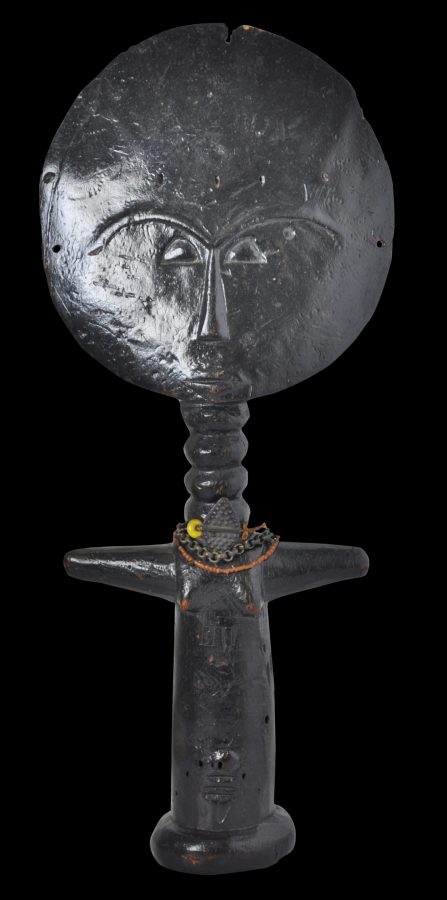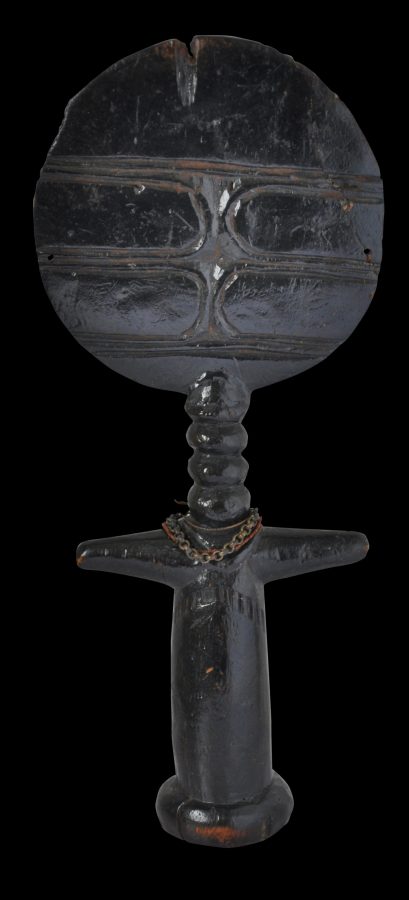Enquiry about object: 3895
Ashanti Carved Wooden Fertility Doll (Akuaba)
Ashanti/Asante People, Ghana 19th century
height: 27.3cm, width: 11.5cm
Provenance
UK art market; the base with an old label for 'Ratton, Paris'.
This highly stylised wooden doll is from the Ashanti, the largest sub-group of the Akan people. Many reproductions of such dolls exist but this example is very ‘real’ in every respect: it has unquestionable patina, is made of very light wood, and retains an old label on its base for the tribal art gallery ‘Ratton, Paris’.
This doll demonstrates the carving skills of Ashanti carvers. The characteristic features of such dolls are a flat round disk-like head, a high forehead, annulated neck, outstretched arms and female sex. Such characteristics symbolised desirable traits for a woman in Ashanti society. The over-sized head symbolised intelligence. The roundness of the face symbolised beauty. The annulated neck symbolised fatness – a sign of prosperity. Outstretched arms suggest generosity.
A panel of engraved designs is on the back of the head. Such designs were believed to be a protective device against witchcraft.
A small metal chain, a beaded necklace, and another necklace with a bead and a metal pendant decorate the neck. Each of these elements has clear age. Small holes have been drilled on each side of the head to allow for the face to be decorated with earrings.
Such dolls tended to be between 20cm and 40cm so the example here is mid-ranged in height.
They played multiple roles for an Ashanti girl: they served as playthings, were supposed to promote her fertility; and served as a protective charm during pregnancy. Often they were given to young Ashanti girls to promote their motherhood role. Caring for such dolls also was thought to promote fertility. Often such dolls were worn strapped to the back like a real infant.
The dolls were consecrated by priests. Tradition has it that a woman, called Akua, was barren. She consulted a priest for advice. The priest suggested that she commission a carver to produce a small wooden child (dua ba). She then had to care for the wooden child as if it were her real baby. This she did, despite being mocked by the other women in the village. But, she had a beautiful daughter eventually. Thereafter, Ashanti women carried these dolls around to promote their fertility.
Traditionally, Ashanti mothers preferred daughters. Ashanti society is matrilineal, which means a daughter will carry on the family name and inherit property.
They would take extreme care during their pregnancies to avoid looking at anything ugly or deformed. They believe that the foetus may be affected by the view of ugly things. Therefore, by looking at the akuaba dolls (or plural akuamma), the expectant mothers imbue their foetus with the ideal of beauty.
The doll here is in fine condition. It has excellent age and a lustrous patina.
References
Bacquart, J. B., The Tribal Arts of Africa, Thames & Hudson, 1998.
Hooper, S. (ed.), Robert and Lisa Sainsbury Collection: Pacific, African and Native North American Art, Yale University Press/University of East Anglia, 1997.
Robbins, W. M. & N. I. Nooter, African Art in American Collections, Smithsoian Institution Press, 1989.
Scanzi, G.F., Akan: Statuary of the Côte d’Ivoire, Ed. Tribaleglobale Primary Art, 2010.
Thompson, R. F., African Art in Motion: Icon and Act, University of California Press, 1974.





